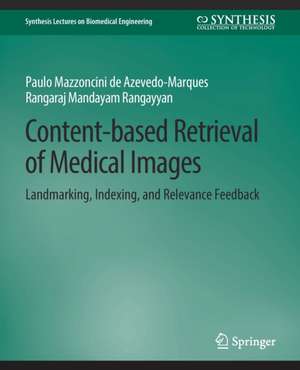Content-based Retrieval of Medical Images: Landmarking, Indexing, and Relevance Feedback: Synthesis Lectures on Biomedical Engineering
Autor Paulo Mazzoncini de Azevedo-Marques, Rangaraj Rangayyanen Limba Engleză Paperback – 25 ian 2012
Din seria Synthesis Lectures on Biomedical Engineering
- 17%
 Preț: 362.03 lei
Preț: 362.03 lei - 15%
 Preț: 522.24 lei
Preț: 522.24 lei - 5%
 Preț: 364.74 lei
Preț: 364.74 lei - 5%
 Preț: 525.89 lei
Preț: 525.89 lei - 15%
 Preț: 636.80 lei
Preț: 636.80 lei -
 Preț: 382.95 lei
Preț: 382.95 lei -
 Preț: 268.83 lei
Preț: 268.83 lei -
 Preț: 260.77 lei
Preț: 260.77 lei -
 Preț: 266.32 lei
Preț: 266.32 lei -
 Preț: 265.18 lei
Preț: 265.18 lei -
 Preț: 262.47 lei
Preț: 262.47 lei -
 Preț: 204.76 lei
Preț: 204.76 lei -
 Preț: 268.66 lei
Preț: 268.66 lei -
 Preț: 262.47 lei
Preț: 262.47 lei -
 Preț: 206.84 lei
Preț: 206.84 lei -
 Preț: 321.54 lei
Preț: 321.54 lei -
 Preț: 192.05 lei
Preț: 192.05 lei -
 Preț: 261.32 lei
Preț: 261.32 lei -
 Preț: 261.53 lei
Preț: 261.53 lei -
 Preț: 206.84 lei
Preț: 206.84 lei -
 Preț: 349.36 lei
Preț: 349.36 lei -
 Preț: 260.95 lei
Preț: 260.95 lei -
 Preț: 204.76 lei
Preț: 204.76 lei -
 Preț: 391.02 lei
Preț: 391.02 lei -
 Preț: 268.83 lei
Preț: 268.83 lei -
 Preț: 205.92 lei
Preț: 205.92 lei -
 Preț: 382.57 lei
Preț: 382.57 lei -
 Preț: 346.48 lei
Preț: 346.48 lei -
 Preț: 264.41 lei
Preț: 264.41 lei -
 Preț: 384.48 lei
Preț: 384.48 lei -
 Preț: 259.04 lei
Preț: 259.04 lei -
 Preț: 260.95 lei
Preț: 260.95 lei -
 Preț: 261.32 lei
Preț: 261.32 lei -
 Preț: 158.66 lei
Preț: 158.66 lei -
 Preț: 267.86 lei
Preț: 267.86 lei -
 Preț: 207.65 lei
Preț: 207.65 lei -
 Preț: 205.92 lei
Preț: 205.92 lei -
 Preț: 268.66 lei
Preț: 268.66 lei -
 Preț: 322.31 lei
Preț: 322.31 lei -
 Preț: 205.70 lei
Preț: 205.70 lei -
 Preț: 226.22 lei
Preț: 226.22 lei - 15%
 Preț: 404.48 lei
Preț: 404.48 lei -
 Preț: 383.71 lei
Preț: 383.71 lei -
 Preț: 273.45 lei
Preț: 273.45 lei -
 Preț: 207.06 lei
Preț: 207.06 lei -
 Preț: 263.06 lei
Preț: 263.06 lei -
 Preț: 260.77 lei
Preț: 260.77 lei -
 Preț: 205.33 lei
Preț: 205.33 lei
Preț: 263.28 lei
Nou
Puncte Express: 395
Preț estimativ în valută:
50.38€ • 53.87$ • 42.00£
50.38€ • 53.87$ • 42.00£
Carte tipărită la comandă
Livrare economică 17 aprilie-01 mai
Preluare comenzi: 021 569.72.76
Specificații
ISBN-13: 9783031005237
ISBN-10: 3031005236
Ilustrații: XIX, 125 p.
Dimensiuni: 191 x 235 mm
Greutate: 0.26 kg
Editura: Springer International Publishing
Colecția Springer
Seria Synthesis Lectures on Biomedical Engineering
Locul publicării:Cham, Switzerland
ISBN-10: 3031005236
Ilustrații: XIX, 125 p.
Dimensiuni: 191 x 235 mm
Greutate: 0.26 kg
Editura: Springer International Publishing
Colecția Springer
Seria Synthesis Lectures on Biomedical Engineering
Locul publicării:Cham, Switzerland
Cuprins
Introduction to Content-based Image Retrieval.- Mammography and CAD of Breast Cancer.- Segmentation and Landmarking of Mammograms.- Feature Extraction and Indexing of Mammograms.- Content-based Retrieval of Mammograms.- Integration of CBIR and CAD into Radiological Workflow.
Notă biografică
Paulo Mazzoncini de Azevedo-Marques is a full-time Associate Professor of Medical Physics and Biomedical Informatics with the Internal Medicine Department, University of São Paulo (USP), School of Medicine, in Ribeirão Preto, SP, Brazil. He received his B.Sc. and M.Sc. degrees in Electrical Engineering in 1986 and 1990, respectively, and his Ph.D. in Applied Physics in 1994, from USP. He has previously worked on medical imaging quality control; since 1996, his research has focused on medical image processing. He held a research associate position at the University of Chicago in 2001, where he worked on medical image processing for computer-aided diagnosis (CAD) and content-based image retrieval (CBIR), under the supervision of Professor Kunio Doi. His main subject interest areas are CAD, CBIR, and picture archival and communication systems (PACS). Rangaraj Mandayam Rangayyan is a Professor with the Department of Electrical and Computer Engineering, and an Adjunct Professor of Surgery and Radiology, at the University of Calgary, Calgary, Alberta, Canada. He received the Bachelor of Engineering degree in Electronics and Communication in 1976 from the University of Mysore at the People’s Education Society College of Engineering, Mandya, Karnataka, India, and the Ph.D. degree in Electrical Engineering from the Indian Institute of Science, Bangalore, Karnataka, India, in 1980. His research interests are in the areas of digital signal and image processing, biomedical signal analysis, biomedical image analysis, and computer-aided diagnosis. He has published more than 150 papers in journals and 250 papers in proceedings of conferences. His research productivity was recognized with the 1997 and 2001 Research Excellence Awards of the Department of Electrical and Computer Engineering, the 1997 Research Award of the Faculty of Engineering, and by appointment as a “University Professor” in 2003, at the University of Calgary. He is the author of two textbooks: Biomedical Signal Analysis (IEEE/Wiley, 2002) and Biomedical Image Analysis (CRC, 2005).He has coauthored and coedited several other books, including one on Color Image Processing with Biomedical Applications (SPIE, 2011). He was recognized by the IEEE with the award of the Third Millennium Medal in 2000, and was elected as a Fellow of the IEEE in 2001, Fellow of the Engineering Institute of Canada in 2002, Fellow of the American Institute for Medical and Biological Engineering in 2003, Fellow of SPIE: the International Society for Optical Engineering in 2003, Fellow of the Society for Imaging Infor[1]matics in Medicine in 2007, Fellow of the Canadian Medical and Biological Engineering Society in 2007, and Fellow of the Canadian Academy of Engineering in 2009. He has been awarded the Killam Resident Fellowship thrice (1998, 2002, and 2007) in support of his book-writing projects.
